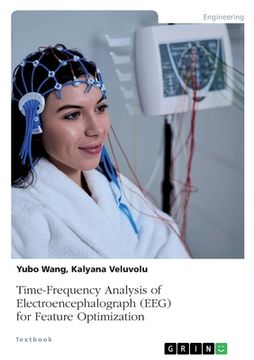Compartir
Time-Frequency Analysis of Electroencephalograph (EEG) for Feature Optimization (en Inglés)
Kalyana Veluvolu
(Autor)
·
Yubo Wang
(Autor)
·
Grin Verlag
· Tapa Blanda
Time-Frequency Analysis of Electroencephalograph (EEG) for Feature Optimization (en Inglés) - Veluvolu, Kalyana ; Wang, Yubo
$ 334.777
$ 669.554
Ahorras: $ 334.777
Elige la lista en la que quieres agregar tu producto o crea una nueva lista
✓ Producto agregado correctamente a la lista de deseos.
Ir a Mis Listas
Origen: Estados Unidos
(Costos de importación incluídos en el precio)
Se enviará desde nuestra bodega entre el
Jueves 01 de Agosto y el
Jueves 15 de Agosto.
Lo recibirás en cualquier lugar de Colombia entre 1 y 5 días hábiles luego del envío.
Reseña del libro "Time-Frequency Analysis of Electroencephalograph (EEG) for Feature Optimization (en Inglés)"
Document from the year 2017 in the subject Medicine - Biomedical Engineering, grade: 3.0, language: English, abstract: Electroencephalograph (EEG) has been widely used for BCI applications due to its non-invasiveness, ease of implementation, and cost-efficiency. The collected EEG signal is non-stationary and has task-related information buried in the frequency and temporal domains. In this book, we focused on developing time-frequency decomposition methods for improving the feature extraction module in BCI systems. The obtained features are then optimized by identifying subject-specific reactive band and employing evolutionary algorithm-based methods for optimizing the obtained features, improving the BCI systems' performance. A signal model named as band-limited multiple Fourier linear combiner (BMFLC) is employed to model the non-stationarity in the EEG signal for feature extraction. The non-stationary amplitude oscillation is presented as adaptive weights in the model and estimated with various adaptive filters such as least-mean square (LMS), Kalman filter (KF), or Kalman Smoother (KS). The estimated coefficients serve as features for classification. Our results suggest that the BMFLC-LMS, BMFLC-KF, and BMFLC-KS are all sufficient in modeling EEG signal in the band with average estimation accuracies of 93%, 99%, and 98%, respectively. We modelled motion-induced EEG signal in frequency domain. We found that most subjects present a subject- specific reactive band during motion tasks. We then constructed features for a classifier that used only the frequency information in the subject-specific reactive band. As a result, the classification accuracy of the BCI system is improved compared to the system which uses the complete band information. Features obtained from multiple EEG channels need to be optimized to enhance the performance of the BCI systems. Essentially, two problems need to be resolved: 1) volume conduction; 2) dimensionality. The volume conduction
- 0% (0)
- 0% (0)
- 0% (0)
- 0% (0)
- 0% (0)
Todos los libros de nuestro catálogo son Originales.
El libro está escrito en Inglés.
La encuadernación de esta edición es Tapa Blanda.
✓ Producto agregado correctamente al carro, Ir a Pagar.

